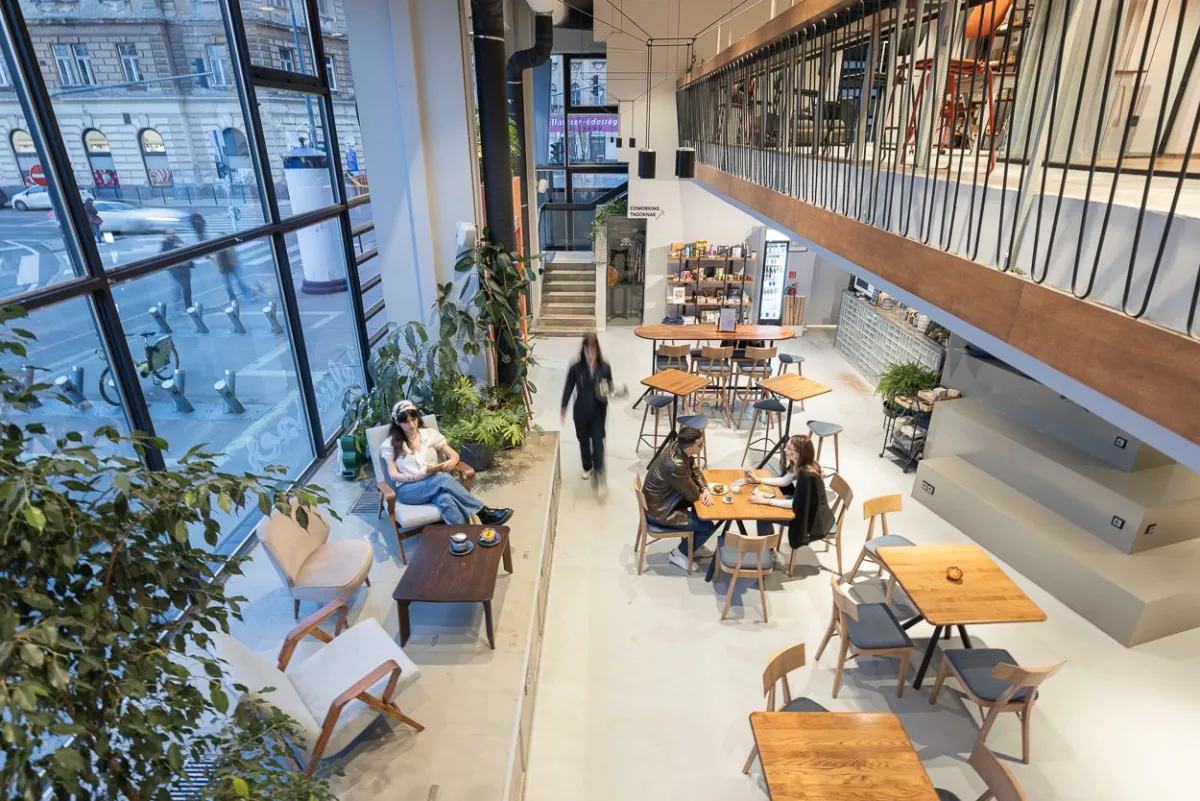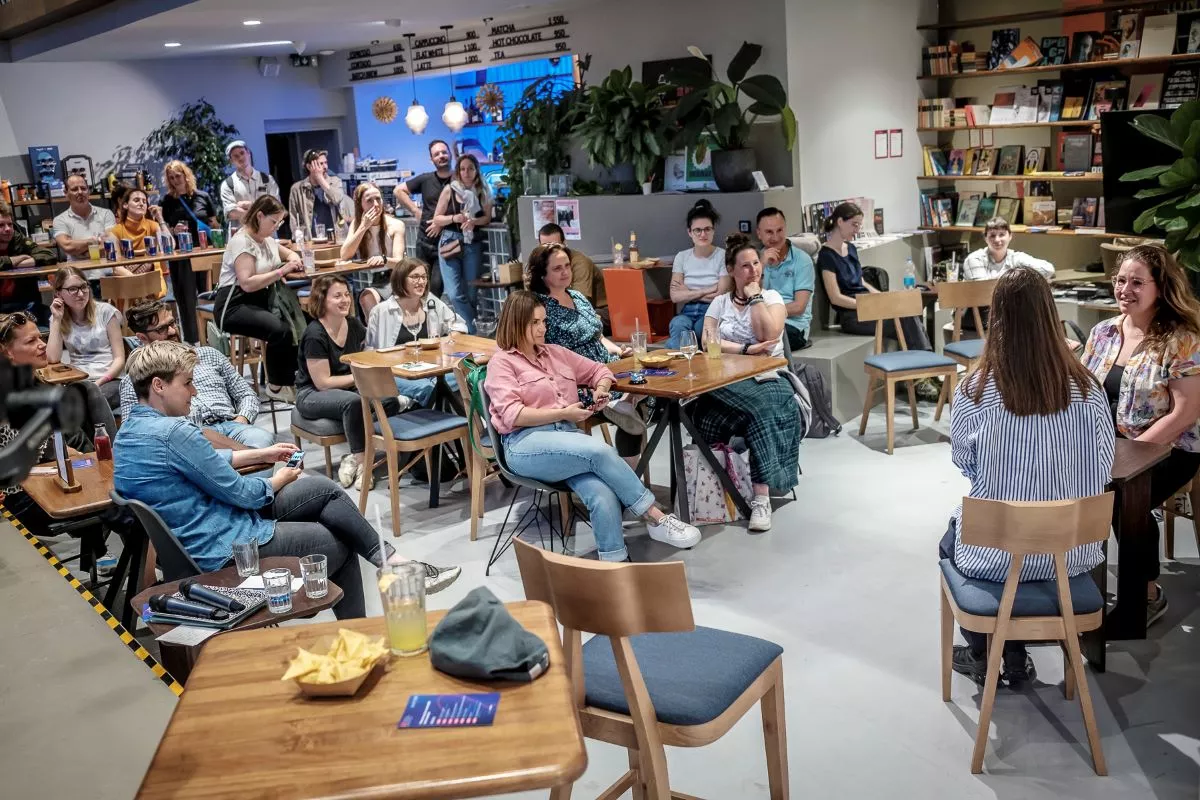From Ugly Duckling to Community Hub - The Story of Kastner Kommunity
Launched in 2021 with a well-thought-out concept tailored to freelancers and fine-tuned during the pandemic, Kastner Kommunity opened its doors on II. János Pál Pápa Square in Budapest. Today, the café, community and coworking space operates as a successful business model, an event and art venue - and not least, it serves as the headquarters of the Kastner agency.
Inside the spacious, bright interior, creative buzz is unmistakable, yet the noise level is no more than that of a regular office. Natural light floods in through the huge windows, offering a view of the park across the street, creating a soothing, nature-inspired atmosphere. This is complemented by the aroma of freshly brewed coffee and baked goods.
 Photo: Balázs Mohai
Photo: Balázs Mohai
Rotating monthly exhibitions adorn the walls — currently extended until May 11, visitors can view the brilliant social commentary of illustrator Kornél Rátkai. Following this, on May 13 at 6:30 PM, the “Defenseless Story” exhibit by Sándor Imreh (Menetmen), winner of the 2024 Art Open Grand Prize, will open. Curating the Kommunity's art programs is Korinna Tánczos, who also serves as Kastner’s Art Director. Since opening, the Kommunity has hosted more than 40 exhibitions featuring both Hungarian and international artists — from high-profile names to significant voices in the alternative art world. The two-story space also includes a silent corner dedicated to confidential work and video calls.
Kornél Rátkai’s exhibition humorously and ironically reflects on today’s social phenomena, the world of social media, and the absurdities of everyday life. On Instagram, he shares his witty and ironic illustrations with over 17,000 followers, offering a satirical lens on modern society. The exhibition brings these digital works into physical form, allowing visitors to engage with them on a deeper level.
“We had a clear vision for the location: we were looking for an ugly duckling that we could raise into something beautiful. The more we looked, the more we knew what we wanted. We deliberately avoided the usual downtown hotspots, opting instead for a district full of potential but not yet fully vibrant. The building, the Buváti House, was built in the 1960s — it once housed the Mézes Mackó confectionery, then the Pöttyös Bistro. After privatization, it became a furniture store and was later left vacant for years. As it turned out, the owner only wanted to lease it to someone whose concept they could personally support,” explains Andrea Tóth, Managing and Creative Director of Kastner.
Before renovations began in 2019, Kastner conducted research among freelancers. It confirmed a growing trend of working from cafés. Another key insight was that freelancers often crave connection — they don’t always enjoy working alone at home and appreciate a lively, stimulating environment.
The space officially opened in October 2021, and the concept has since proven its value. Not only locals but also visitors from the Budapest metropolitan area and even from other regions of Hungary regularly work here. According to Kastner’s internal surveys, “the space is particularly popular among creatives — web designers, illustrators, social media managers, content creators make up the core clientele, but lawyers and journalists also frequent the venue,” confirms Judit Járadi, project manager of Kastner Kommunity.
Part of Kastner’s 25-person agency team works on the first floor of the Kommunity, while they also maintain a flat-office in the neighboring building. Some work in hybrid mode, but the core team spends significant time together in person. Much of their work targets international markets — for example, they coordinate Red Bull's campaigns across more than 30 countries from here, while also focusing heavily on brand building for other clients.
Kastner Kommunity’s model also addresses employee retention. The space enables staff not only to work on agency projects but also to showcase their personal creative endeavors. “It’s not uncommon for someone to first fall in love with the space and only later apply to the agency. One current colleague sent a cold email after the Kommunity’s atmosphere convinced them they wanted to work here. And it’s not just full-time hires — we’ve signed several freelancers for project work after they became regular visitors to the coworking space. It’s a clear sign that the space itself attracts creative professionals,” says Andrea Tóth.
 Photo: Bence Illyés
Photo: Bence Illyés
Another example of Kommunity’s effectiveness was the recruitment of the Budapest team for Kastner Kartoon, the agency’s animation studio. Since many of the space’s visitors work in the creative industries, they received numerous excellent recommendations.
Kastner Kommunity is not just an experiment in creative corporate philosophy — it’s a financially viable business model. For clients, this cultural presence and up-to-date sensibility represent unique added value, as the team maintains direct contact with the latest art and cultural trends. The concept has proven so successful that similar venues have opened since. The merging of community space and agency has created a model increasingly attracting attention from other creative businesses — and its elements are now being adopted by other workplaces and hospitality venues.
Kastner is an independent advertising agency founded in 1982 by copywriter Johannes Kastner in Frankfurt. Today, it operates eight offices worldwide — including one in Budapest for over 20 years — and has worked with the Red Bull brand for more than 35 years. The agency’s philosophy holds that strong brand building is not only about campaigns but about genuine cultural and social engagement.
“As an international agency, we feel it is our duty to give back to the community. We contribute to rebranding the neighborhood using our expertise in brand building. For instance, we co-launched the ‘Külkörút’ initiative with local partners and also participate in district development discussions that affect us,” says Andrea Tóth.
Kornél Rátkai’s unique drawing style and sharp social commentary spotlight modern dilemmas and familiar situations. His illustrations respond simultaneously to the quirks of digital life and the big questions of existence — with irony and sometimes painfully accurate humor. The exhibition’s title, “The Place of the Wisdom Tooth,” alludes to that strange borderland where deep truth and empty cliché blur — just like Kornél’s works play with the appearance of wisdom, raising more questions than offering answers.
The goal of the exhibition is to give visitors a momentary escape from constant online presence — to laugh, reflect, and look at their everyday reality with new eyes.




